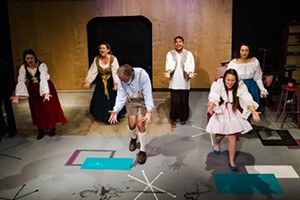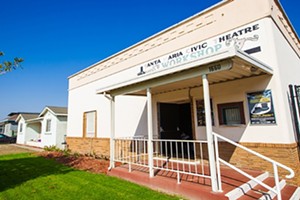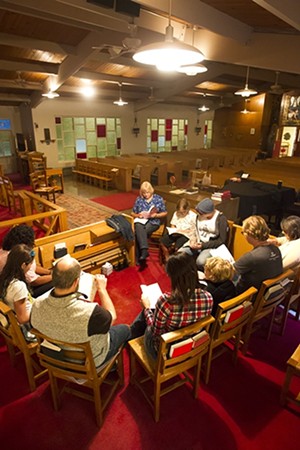What does it take to keep a community theater open?
There isn’t one simple answer.

Theater groups up and down the Central Coast have been around for decades. Some have come and gone, yet others have more staying power.
While groups like the Santa Maria Civic Theatre are fortunate to have a permanent location, that isn’t always the case for others, and they have to make do with the venues available. Some groups aren’t afraid to change up the kinds of plays they produce, or reach out to a new audience. And now, with the San Luis Obispo Little Theatre (now SLO Repertory Theatre) recently going professional, community theater groups are even more spread out across SLO and Santa Barbara counties.
The Sun talked with several community theater groups, and we present to you a collection of stories about the highs and lows of putting on a show on the Central Coast.
Comeback kids
Founded in 1959, the Santa Maria Civic Theatre was the first organization to offer live theater on the regular in the city. But longevity doesn’t always translate to success.

John Shade started out as a patron of the theater in 2009 and then became a member of its board in 2012. At least as long as he’s been on the board, Shade says ticket sales have been all over the place. The 100-seat theater isn’t big, but some shows like musicals or more well-known plays would sell maybe 50 to 100 seats a night and others would only sell 15 to 20 seats each show. Shade said it didn’t necessarily link to the quality of the acting or even the play itself. In 2013, the venue started selling tickets online and that helped. But the real turning point was in August, when the theater put on a production of the hit musical Hairspray. The show ran for three weeks, and all but one performance completely sold out, and that show was added last minute to accommodate people who couldn’t get into the other shows.
What changed? Shade said they focused more of their efforts on building up the theater’s email list and social media presence and also threw more of its advertising dollars at radio. But beyond the business savvy, Shade said that Hairspray has a timeless message showing our nation’s past struggles with racism. And with white supremacists rioting in Charlottesville during the run of the show, Shade said it might have felt especially poignant to audiences. He even heard a young theatergoer of color asking his parents why white characters in the play were treating black characters differently.
“Theater actually exposes people to things they might not be aware of,” Shade said. “That was one of those times where current life and what’s happening onstage really came together for an emotional event.”
How the Santa Maria Civic Theatre plans a season has changed as well, Shade explained. He said there is a focus on a broad lineup of plays across the year, with at least one musical and plays with a more serious tone.
The more serious, actor-driven plays may not attract the sold-out crowds, he said, but they definitely make longtime civic theater fans happy.

“Our patrons have said we are picking up our game, and the quality of the production quality of our shows has increased,” he said. “They want to come back no matter what the show is, so I think that helps the big shows with big draw, but it also helps the little ones as well.”
But that doesn’t mean they don’t like to get silly every now and then.
Shade said the Civic Theatre decided not to do a Christmas show this year, which most community theater groups do, but instead to focus on Halloween with a production of Young Frankenstein. The show is a comedy but may be more appropriate for theatergoers 15 years and older, he said, because there’s a lot of innuendo.
“I know the actors are having a great time working on their characters, and from what I’m told, it’s a laugh fest from beginning to end,” he said.
Marvelous monsters
Catch a showing of Young Frankenstein at the Santa Maria Civic Theatre from Oct. 20 to Nov. 5. Tickets range from $15 to $20. Visit smct.org for more details.
One theater, many homes
The Lompoc Civic Theatre (LCT) has been around for more than four decades now, and when it started, its numbers and venues were humble.
Current LCT board President Larry McLellan said that the original rehearsals were in people’s living rooms, and the group only performed a couple of times a year. The theater group has enjoyed a surge of new talent and more interesting programming over the last few years, McLellan said, but they still struggle with visibility in Lompoc.
“I moved to Lompoc in 2003, and I was here for three years before I knew it existed. It’s one of those things where publicity is kind of the downfall of community theater,” McLellan said. “We always run into locals who have grown up in Lompoc and it’s like, ‘Oh, I had no idea there was a theater group here.’ I don’t think that’s an uncommon thing.”
When McLellan first got involved with LCT years ago, he joined the programming committee, he said, and tried to steer the seasons away from things like murder mysteries and more toward engaging plays that community theaters could program.
Currently, LCT has different venues they use depending on the kind of play they’re producing. There’s the Lompoc Civic Auditorium, which seats 400, McLellan said, but even a house of 100 guests can feel a bit empty, so directors are reluctant to stage anything there, he said.
There’s also the Stone Pine Hall, which is run by the Lompoc Museum, and is a much more intimate venue for smaller shows. That’s where LCT has programmed shows like Two Point Oh, a newer play that utilized multimedia for a plot that involved transhumanism and technology.
But another LCT tradition that is still upheld is their dinner theater productions, like the current production, Wally’s Café (see review, page 31). They perform at The Mission Club in Lompoc—which makes great food, McLellan said—on weekends during a run.
“It’s a space that holds about 50 people, max, and it’s a bar and grill with TV screens on the walls, and so we have creative ways to disguise the performance space,” he said. “We have those three different venues, and I think in a certain sense, it’s probably more of a blessing than a curse.”
McLellan said that having different options in town allows LCT to program different kinds of plays throughout a season.
That freedom has allowed LCT to explore various formats, like maybe a musical, more experimental shows like Two Point Oh, and even a readers theater.
“I’ve had a lot of people come up to me after shows and say that, ‘Over the past few years, you guys have been doing more interesting, contemporary, and challenging shows,’” he said.
Delicious dinner theater
The Lompoc Civic Theatre presents its dinner theater production of Wally’s Café on Oct. 6, 7, 13, and 14 with dinner at 5:30 and the show at 6:30 p.m. at The Mission Club in Lompoc. More info: 735-2281 or lct.lbee.com.
A brief intermission
The lights may be out, but things are definitely still underway over at Central Coast Theater Works in Nipomo.
With its home at the Monarch Club, the organization started in 2015 under the umbrella of the Nipomo Recreation Association. Mary Meserve-Miller—who formerly acted, fundraised, wrote, and produced for the SLO Little Theatre—took the helm of Central Coast Theater Works in 2016 but resigned in July 2017, causing the group to cancel the rest of its planned season. Both Meserve-Miller and her direct supervisor, Jeff Long, executive director for the association, declined to comment on what led to the resignation. However, Long said the theater will go on, and he’s looking to hire an artistic director/producer.
“Somebody who wants to take it off my plate, but has no problem answering to me,” Long said.
Coming soon …
Central Coast Theater Works hopes to have a production up on stage in time for the holidays. Check in at nipomorecreation.org/cctw for updates.
Changes in Cambria
It all started in 1999, one night over chardonnay in the theater in Cambria. One drink led to another and a few years later they were married on a gondola at the Venetian in Las Vegas.
Today Rebecca Buckley is a widow in her 70s, but she still has her husband Jim Buckley’s legacy, the Pewter Plough Playhouse, at least for the time being. Amid money woes, Rebecca put the theater up for sale to the tune of $1.3 million in August.
“I figured that would be the best way out of it, so I could pay all the bills and have a stress-free life,” Rebecca said.
On a sunny afternoon in Cambria at the end of August, Rebecca sipped tomato soup at the Harmony Café, located just outside her theater on Main Street, as she shared some big news: barring an over-the-top offer, she’d decided not to sell the Pewter Plough Playhouse after all.
“My first inclination would be to sell it, but then part of me wants to carry it on,” Rebecca said. “Everyone knew I was in that quandary, sell or stay. Everyone loves the theater, how can I just ignore all of that? I can’t. Those things were gnawing on me.”
Jim founded the theater in 1976 and threw himself and often his own personal funds into the productions. When Jim died at age 103 in 2015, Rebecca, who had helped him run the theater during their marriage, took over at the beginning of 2017 and shook things up a bit. Before his death, the couple had discussed parting ways with the Pewter Plough Players, the nonprofit group that put on shows at the theater, in order to gain more artistic control. So Rebecca let the Players’ lease expire at the end of 2016 and added musical acts to the theater’s offerings. She dropped $8,000 on a new curtain for the stage and another $18,000 on a new Steinway piano for the musicians to play. All told, from 2015 to present, the Buckleys spent $70,000 on improvements and refurbishments.
She put the word out in local newspapers and printed out flyers and programs. The costs started to add up, currently Rebecca said the theater is in about $12,000 worth of debt between things like marketing-related expenses and utilities (the electric bill can cost around $300 a month to power all the lights on stage and in the theater building).
So Rebecca stepped back and simplified. The music acts weren’t breaking even, so she canceled those and went back to what she knew best: putting on plays. She said the Playhouse is shooting to pay all of its bills off by October.
“I think it’s a necessary art form,” Rebecca said of community theater. “Not only for the older people to come and have entertainment, but for the youth to have a place to learn and experience theater as they’re growing up. I think it rounds out a community.”
Just a few days after talking with the Sun, Rebecca sent an email and said she’d changed her mind again. She would keep the playhouse on the market at least until the end of the year and sell if someone offered the $1.3 million she asked for and agreed to keep the building going as an arts center. As of press time, no offers have come in. Stay tuned.
Currently on stage
The Golden Age is on stage at the Pewter Plough Playhouse in Cambria through Oct. 1. General admission is $20 and tickets for those 30 and under are $15. Visit pewterploughplayhouse.net for more information.
Act II
When the Pewter Plough Players were kicked out of the only theatrical home they’d ever known at the end of last year, they decided to take it as an opportunity to branch out beyond Cambria.
“She [Rebecca] wanted to go in a different direction so she decided not to renew our lease,” said Anita Schwaber, president of the board for the players. “She wanted to do it herself, she wanted to establish it as more of a performing arts center.”

But when one stage curtain drops, another opens.
“We were disappointed, but we decided to move on and relocate to Morro Bay, which is a city that to my knowledge hasn’t had consistent live theater,” Schwaber said. “We’ve decided to establish our own identity.”
And while the group still retains the name they’ve had for the last 15 years, Pewter Plough Players, as their official 501C3 name, they’re now publicly known as By the Sea Productions since they perform at the Erickson Parrish Hall at St. Peter’s By the Sea Episcopal Church in Morro Bay. The group is nearing its one-year mark at the new venue.
While their old home is up for sale, Schwaber said not to expect a return to Cambria.
“It’s been discussed, but it’s not really a viable possibility. I certainly don’t have the money,” Schwaber said. “I could be torn, but I really love where we are right now and that we’re filling a need in our community.”
Coastal entertainment
By the Sea Productions presents The Member of the Wedding from Oct. 20 to Nov. 5. Tickets are $20 for regular shows and $25 for the show on Oct. 22 that includes a champagne reception. Visit bytheseaproductions.org for more information.
Ryah Cooley, arts editor for the New Times, can be reached at [email protected]. Sun Managing Editor Joe Payne contributed to this story.








